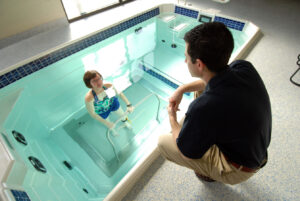Comorbidities & Aquatic Therapy
What Is A Comorbidity
Arthritis, fibromyalgia, orthopedic conditions, chronic pain, neuromuscular and neurological conditions, obesity.
Sometimes, several of these conditions occur simultaneously in a patient. This is known as comorbidity. Having comorbidities can make it next to impossible for some patients to participate in traditional land-based therapy. And compliance—the patient’s ability to keep regular appointments and progress through a treatment plan—is often compromised due to the difficulty and pain associated with the task.
Intrinsic properties of water
Fifteen years ago, nearly 25% of Medicare beneficiaries, age 65 or older, had four or more chronic conditions. That number grows each year. Many aging Americans are precluded from a land-based exercise program due to pain, obesity and a plethora of orthopedic, neurological and neuromuscular conditions. Yet scientific research shows the need to treat comorbid conditions concurrently with prescribed therapeutic means.
Aquatic therapy provides relief and improved outcomes for comorbid patients through water’s intrinsic properties:
- Buoyancy, or upthrust, is the force that opposes the weight of immersed objects. Buoyancy decreases joint stress by assisting in de-weighting patients’ body mass, making it easier and less painful for those suffering from chronic pain or soreness. To create the ideal environment for patients, water levels can be altered, ranging from 10-90% de-weighting of the body. Buoyancy provides instant relief to many who suffer from chronic pain.
- Viscosity, simply stated, is water’s resistive power. It is an excellent source of resistance for strengthening weakened or inactive muscles. Patients can improve mobility and function quickly during sessions in a warm-water pool.
- Hydrostatic pressure is the pressure exerted by a fluid through the force of gravity. It increases in proportion to the patient’s distance from the water’s surface. Hydrostatic pressure increases blood flow and promotes healing. It helps the joints, too; hydrostatic pressure reduces joint inflammation and improves joint position awareness. Corrections to posture require less effort and cause less discomfort. Hydrostatic pressure stimulates trunk stability, body awareness, muscle relaxation and balance, resulting in patients who heal faster and with less pain.
Comorbidities & Aquatic Therapy Research
The University of Wisconsin Department of Kinesiology conducted a study in which fourteen adults with previous histories of physical ailments exercised on a HydroWorx underwater treadmill two days a week, in 40-minute sessions, for five weeks. They performed both aerobic exercises and aquatic resistance training. Participants took a quality of life survey that measured changes in flexibility, ability to perform activities of daily living, energy levels and sleep patterns.
The results of the study showed that patients felt better both physically and psychologically during the exercise period. Seven reported better quality of sleep and 11 reported decreased joint pain.
In our country, approximately 10,000 people turn 65 each day. And this will be true for the next decade and half. New seniors want to stay active and receive unsurpassed medical care, despite having concurring ailments. Water’s intrinsic values—buoyancy, hydrostatic pressure and viscosity—provide the healing they urgently need.
Hydrotherapy For Comorbidities Case Study
Watch this video to see what aquatic therapy has done for Charlene and Kathy, two aquatic patients suffering from multiple diagnoses.
Click here for our white paper “Aquatic Therapy and Arthritis and Fibromyalgia>>


